Christophe Nicolle
Le2i
Combining Machine Learning and Ontology: A Systematic Literature Review
Jan 15, 2024Abstract:Motivated by the desire to explore the process of combining inductive and deductive reasoning, we conducted a systematic literature review of articles that investigate the integration of machine learning and ontologies. The objective was to identify diverse techniques that incorporate both inductive reasoning (performed by machine learning) and deductive reasoning (performed by ontologies) into artificial intelligence systems. Our review, which included the analysis of 128 studies, allowed us to identify three main categories of hybridization between machine learning and ontologies: learning-enhanced ontologies, semantic data mining, and learning and reasoning systems. We provide a comprehensive examination of all these categories, emphasizing the various machine learning algorithms utilized in the studies. Furthermore, we compared our classification with similar recent work in the field of hybrid AI and neuro-symbolic approaches.
Towards Explainability for a Civilian UAV Fleet Management using an Agent-based Approach
Sep 22, 2019


Abstract:This paper presents an initial design concept and specification of a civilian Unmanned Aerial Vehicle (UAV) management simulation system that focuses on explainability for the human-in-the-loop control of semi-autonomous UAVs. The goal of the system is to facilitate the operator intervention in critical scenarios (e.g. avoid safety issues or financial risks). Explainability is supported via user-friendly abstractions on Belief-Desire-Intention agents. To evaluate the effectiveness of the system, a human-computer interaction study is proposed.
IfcWoD, Semantically Adapting IFC Model Relations into OWL Properties
Nov 12, 2015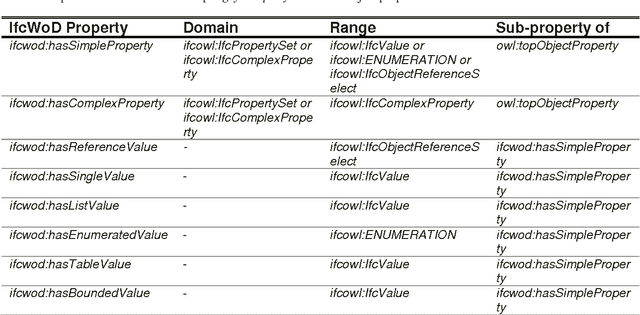
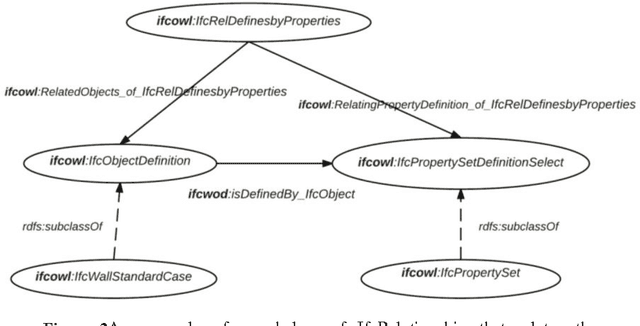


Abstract:In the context of Building Information Modelling, ontologies have been identified as interesting in achieving information interoperability. Regarding the construction and facility management domains, several IFC (Industry Foundation Classes) based ontologies have been developed, such as IfcOWL. In the context of ontology modelling, the constraint of optimizing the size of IFC STEP-based files can be leveraged. In this paper, we propose an adaptation of the IFC model into OWL which leverages from all modelling constraints required by the object-oriented structure of IFC schema. Therefore, we do not only present a syntactic but also a semantic adaptation of the IFC model. Our model takes into consideration the meaning of entities, relationships, properties and attributes defined by the IFC standard. Our approach presents several advantages compared to other initiatives such as the optimization of query execution time. Every advantage is defended by means of practical examples and benchmarks.
From 9-IM Topological Operators to Qualitative Spatial Relations using 3D Selective Nef Complexes and Logic Rules for bodies
Jan 21, 2013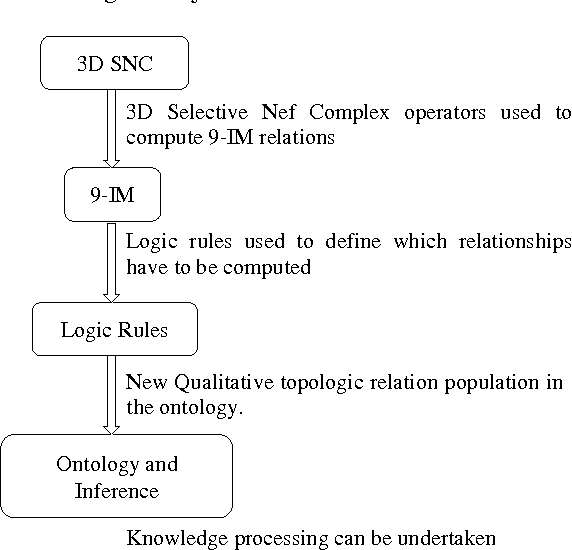
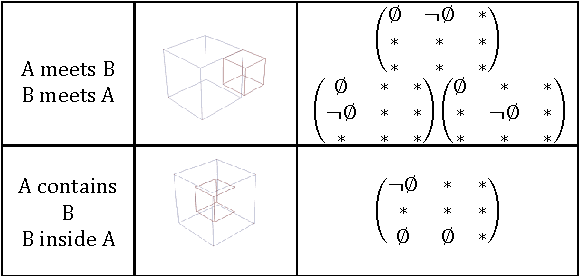
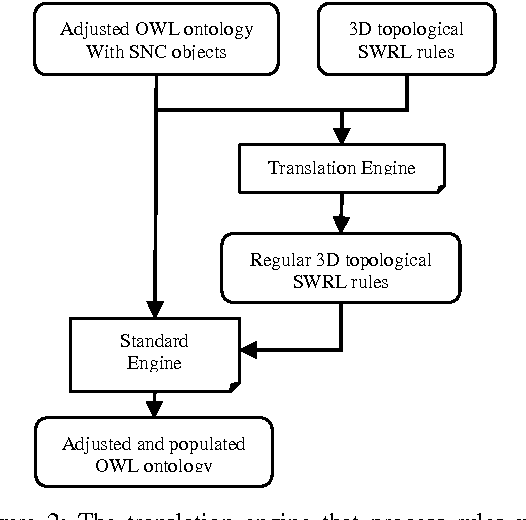

Abstract:This paper presents a method to compute automatically topological relations using SWRL rules. The calculation of these rules is based on the definition of a Selective Nef Complexes Nef Polyhedra structure generated from standard Polyhedron. The Selective Nef Complexes is a data model providing a set of binary Boolean operators such as Union, Difference, Intersection and Symmetric difference, and unary operators such as Interior, Closure and Boundary. In this work, these operators are used to compute topological relations between objects defined by the constraints of the 9 Intersection Model (9-IM) from Egenhofer. With the help of these constraints, we defined a procedure to compute the topological relations on Nef polyhedra. These topological relationships are Disjoint, Meets, Contains, Inside, Covers, CoveredBy, Equals and Overlaps, and defined in a top-level ontology with a specific semantic definition on relation such as Transitive, Symmetric, Asymmetric, Functional, Reflexive, and Irreflexive. The results of the computation of topological relationships are stored in an OWL-DL ontology allowing after what to infer on these new relationships between objects. In addition, logic rules based on the Semantic Web Rule Language allows the definition of logic programs that define which topological relationships have to be computed on which kind of objects with specific attributes. For instance, a "Building" that overlaps a "Railway" is a "RailStation".
* arXiv admin note: substantial text overlap with arXiv:1301.4780
Integration of knowledge to support automatic object reconstruction from images and 3D data
Jan 21, 2013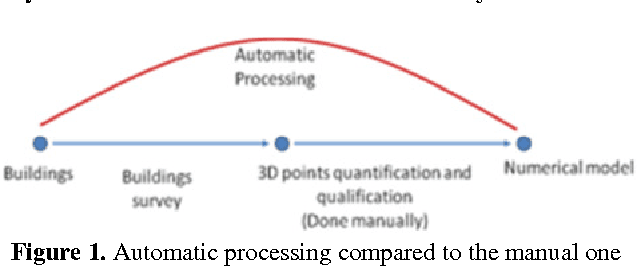

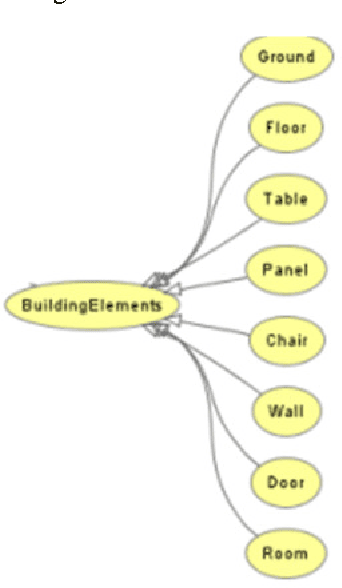

Abstract:Object reconstruction is an important task in many fields of application as it allows to generate digital representations of our physical world used as base for analysis, planning, construction, visualization or other aims. A reconstruction itself normally is based on reliable data (images, 3D point clouds for example) expressing the object in his complete extent. This data then has to be compiled and analyzed in order to extract all necessary geometrical elements, which represent the object and form a digital copy of it. Traditional strategies are largely based on manual interaction and interpretation, because with increasing complexity of objects human understanding is inevitable to achieve acceptable and reliable results. But human interaction is time consuming and expensive, why many researches has already been invested to use algorithmic support, what allows to speed up the process and to reduce manual work load. Presently most of such supporting algorithms are data-driven and concentate on specific features of the objects, being accessible to numerical models. By means of these models, which normally will represent geometrical (flatness, roughness, for example) or physical features (color, texture), the data is classified and analyzed. This is successful for objects with low complexity, but gets to its limits with increasing complexness of objects. Then purely numerical strategies are not able to sufficiently model the reality. Therefore, the intention of our approach is to take human cognitive strategy as an example, and to simulate extraction processes based on available human defined knowledge for the objects of interest. Such processes will introduce a semantic structure for the objects and guide the algorithms used to detect and recognize objects, which will yield a higher effectiveness. Hence, our research proposes an approach using knowledge to guide the algorithms in 3D point cloud and image processing.
Knowledge Base Approach for 3D Objects Detection in Point Clouds Using 3D Processing and Specialists Knowledge
Jan 21, 2013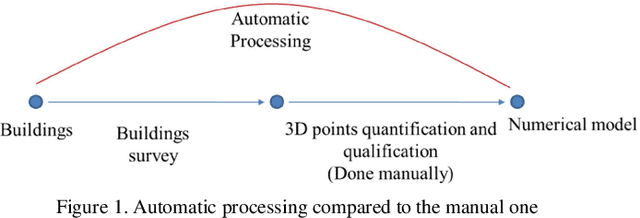
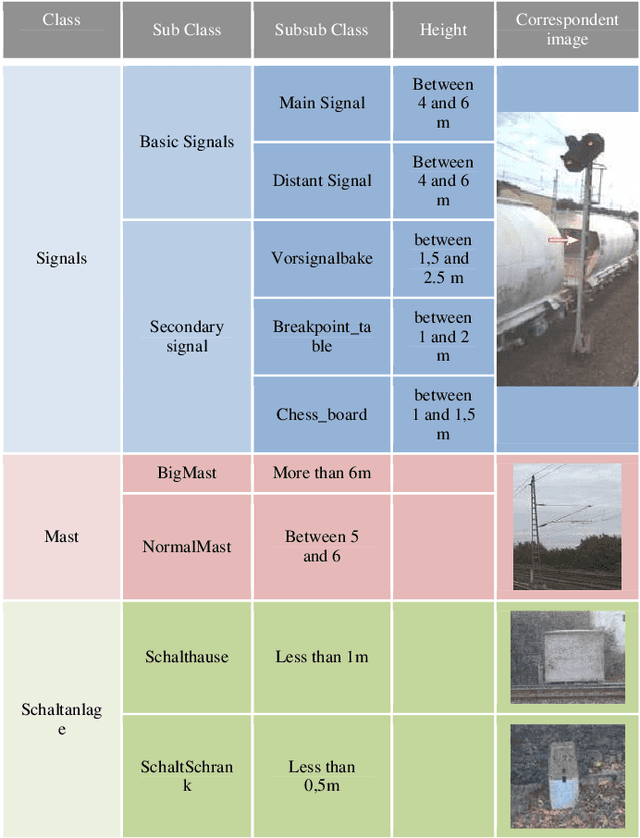
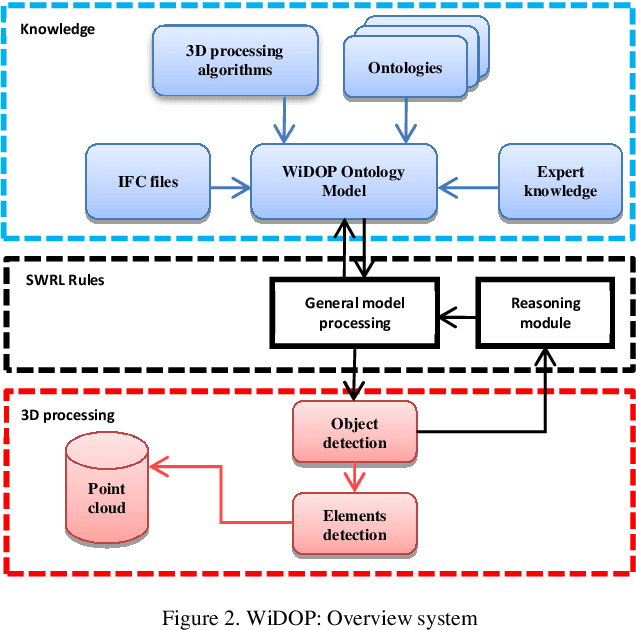
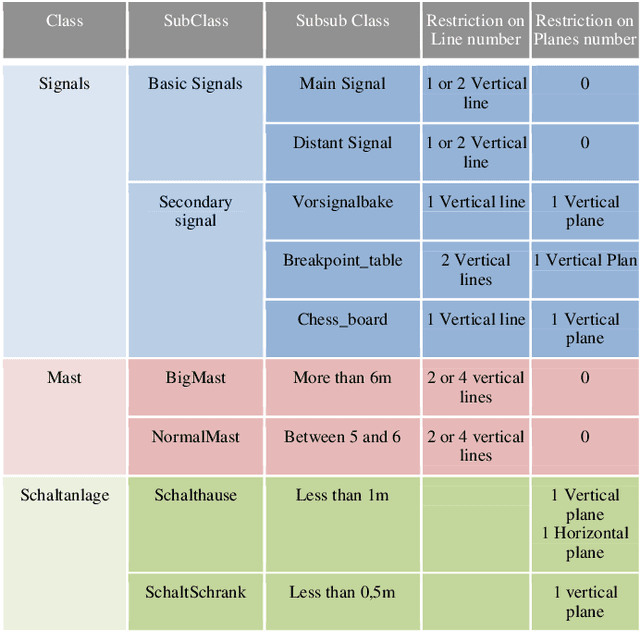
Abstract:This paper presents a knowledge-based detection of objects approach using the OWL ontology language, the Semantic Web Rule Language, and 3D processing built-ins aiming at combining geometrical analysis of 3D point clouds and specialist's knowledge. Here, we share our experience regarding the creation of 3D semantic facility model out of unorganized 3D point clouds. Thus, a knowledge-based detection approach of objects using the OWL ontology language is presented. This knowledge is used to define SWRL detection rules. In addition, the combination of 3D processing built-ins and topological Built-Ins in SWRL rules allows a more flexible and intelligent detection, and the annotation of objects contained in 3D point clouds. The created WiDOP prototype takes a set of 3D point clouds as input, and produces as output a populated ontology corresponding to an indexed scene visualized within VRML language. The context of the study is the detection of railway objects materialized within the Deutsche Bahn scene such as signals, technical cupboards, electric poles, etc. Thus, the resulting enriched and populated ontology, that contains the annotations of objects in the point clouds, is used to feed a GIS system or an IFC file for architecture purposes.
* ISSN: 1942-2679. arXiv admin note: text overlap with arXiv:1301.4783
Toward the Automatic Generation of a Semantic VRML Model from Unorganized 3D Point Clouds
Jan 21, 2013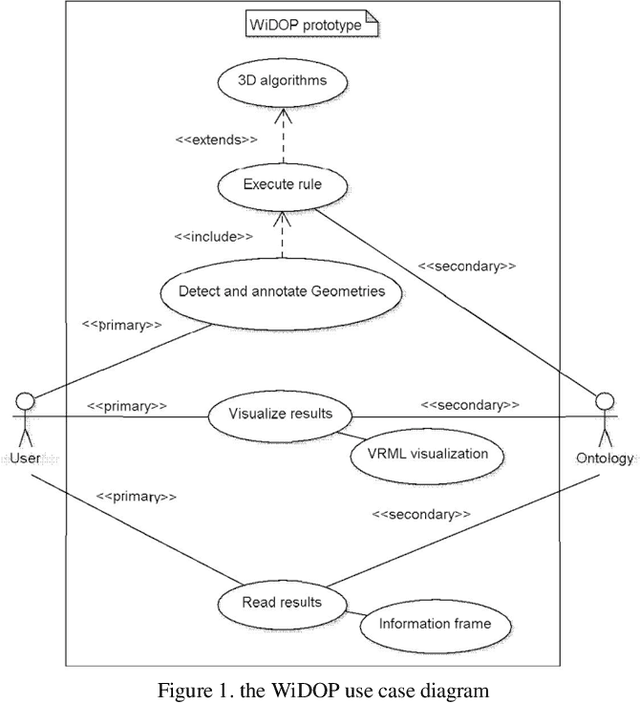

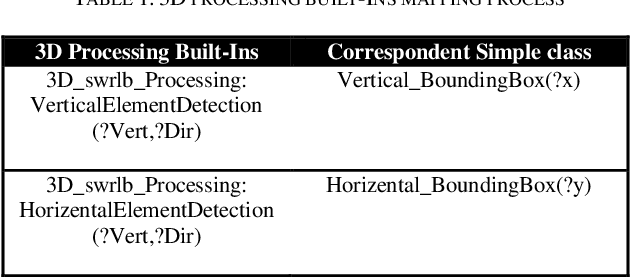

Abstract:This paper presents our experience regarding the creation of 3D semantic facility model out of unorganized 3D point clouds. Thus, a knowledge-based detection approach of objects using the OWL ontology language is presented. This knowledge is used to define SWRL detection rules. In addition, the combination of 3D processing built-ins and topological Built-Ins in SWRL rules aims at combining geometrical analysis of 3D point clouds and specialist's knowledge. This combination allows more flexible and intelligent detection and the annotation of objects contained in 3D point clouds. The created WiDOP prototype takes a set of 3D point clouds as input, and produces an indexed scene of colored objects visualized within VRML language as output. The context of the study is the detection of railway objects materialized within the Deutsche Bahn scene such as signals, technical cupboards, electric poles, etc. Therefore, the resulting enriched and populated domain ontology, that contains the annotations of objects in the point clouds, is used to feed a GIS system.
* arXiv admin note: substantial text overlap with arXiv:1301.4991, arXiv:1301.4783
From 3D Point Clouds To Semantic Objects An Ontology-Based Detection Approach
Jan 21, 2013
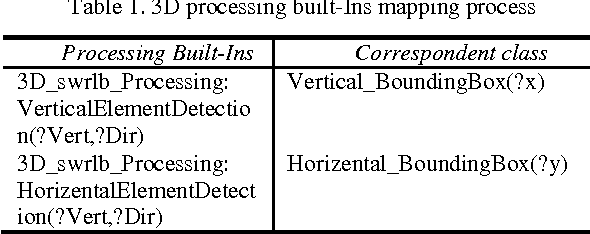
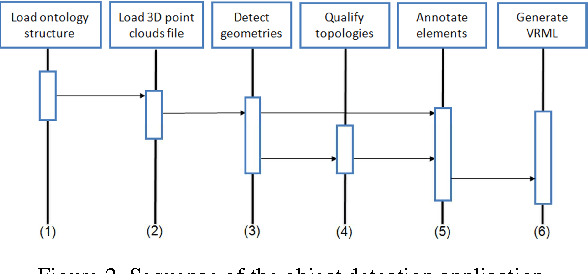
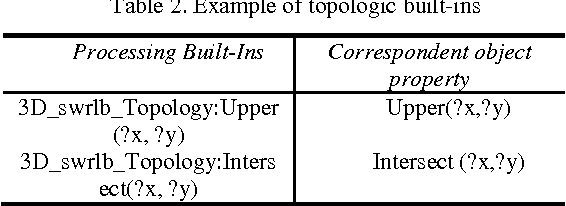
Abstract:This paper presents a knowledge-based detection of objects approach using the OWL ontology language, the Semantic Web Rule Language, and 3D processing built-ins aiming at combining geometrical analysis of 3D point clouds and specialist's knowledge. This combination allows the detection and the annotation of objects contained in point clouds. The context of the study is the detection of railway objects such as signals, technical cupboards, electric poles, etc. Thus, the resulting enriched and populated ontology, that contains the annotations of objects in the point clouds, is used to feed a GIS systems or an IFC file for architecture purposes.
From Quantitative Spatial Operator to Qualitative Spatial Relation Using Constructive Solid Geometry, Logic Rules and Optimized 9-IM Model, A Semantic Based Approach
Jan 21, 2013


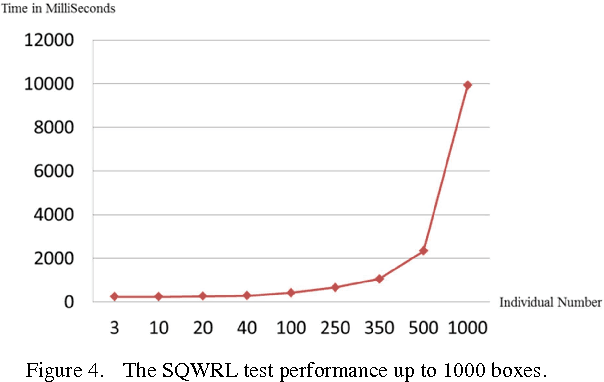
Abstract:The Constructive Solid Geometry (CSG) is a data model providing a set of binary Boolean operators such as Union, Difference and Intersection. In this work, these operators are used to compute topological relations between objects defined by the constraints of the nine Intersection Model (9-IM) from Egenhofer. With the help of these constraints, we define a procedure to compute the topological relations on CSG objects. These topological relations are Disjoint, Contains, Inside, Covers, CoveredBy, Equals and Overlaps, and are defined in a top-level ontology with a specific semantic definition on relation such as Transitive, Symmetric, Asymmetric, Functional, Reflexive, and Irreflexive. The results of topological relations computation are stored in the ontology allowing after what to infer on these topological relationships. In addition, logic rules based on the Semantic Web Language allows the definition of logic programs that define which topological relationships have to be computed on which kind of objects. For instance, a "Building" that overlaps a "Railway" is a "RailStation".
Guidelines for a Dynamic Ontology - Integrating Tools of Evolution and Versioning in Ontology
Aug 08, 2012
Abstract:Ontologies are built on systems that conceptually evolve over time. In addition, techniques and languages for building ontologies evolve too. This has led to numerous studies in the field of ontology versioning and ontology evolution. This paper presents a new way to manage the lifecycle of an ontology incorporating both versioning tools and evolution process. This solution, called VersionGraph, is integrated in the source ontology since its creation in order to make it possible to evolve and to be versioned. Change management is strongly related to the model in which the ontology is represented. Therefore, we focus on the OWL language in order to take into account the impact of the changes on the logical consistency of the ontology like specified in OWL DL.
 Add to Chrome
Add to Chrome Add to Firefox
Add to Firefox Add to Edge
Add to Edge